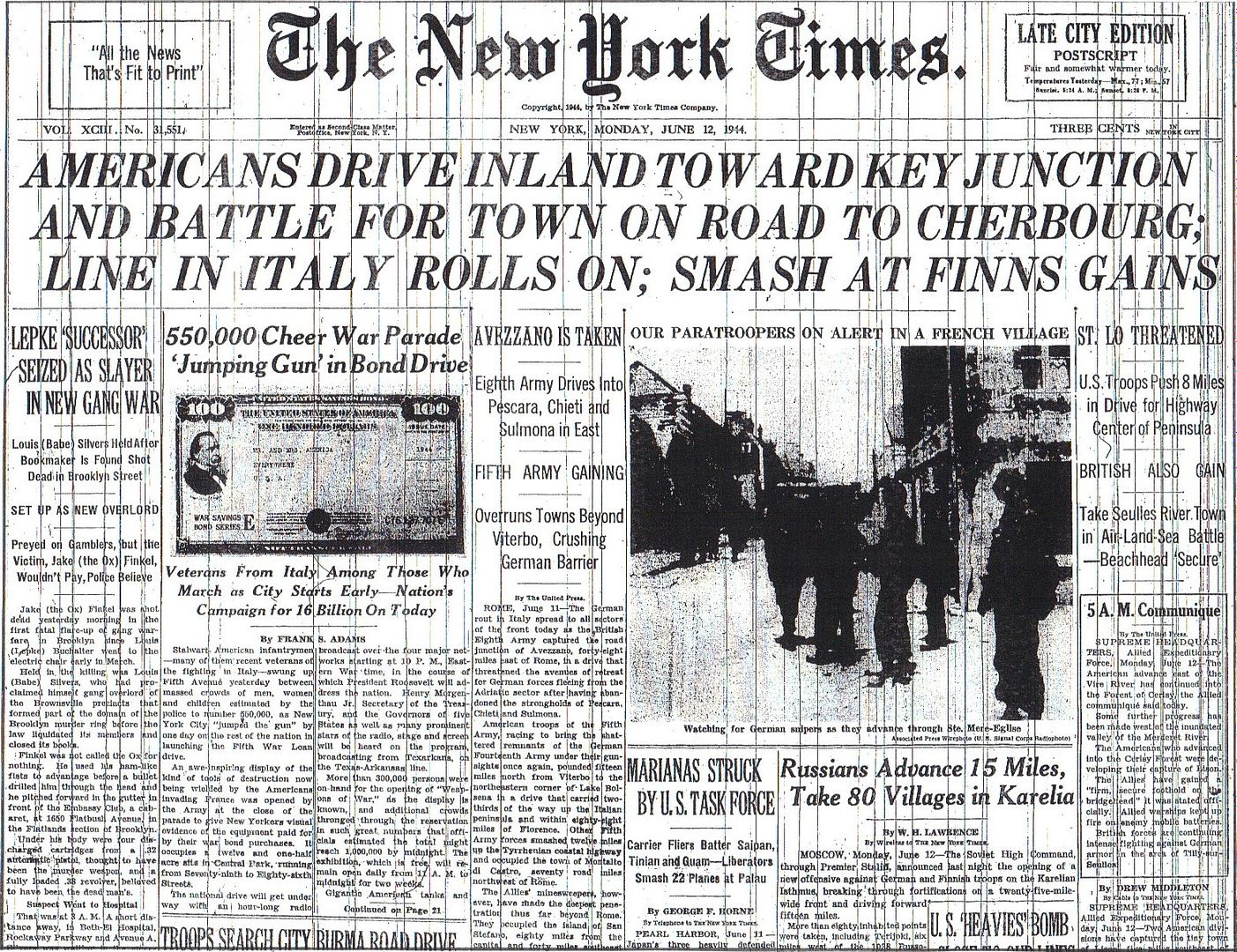
Posted on 06/12/2014 4:27:28 AM PDT by Homer_J_Simpson

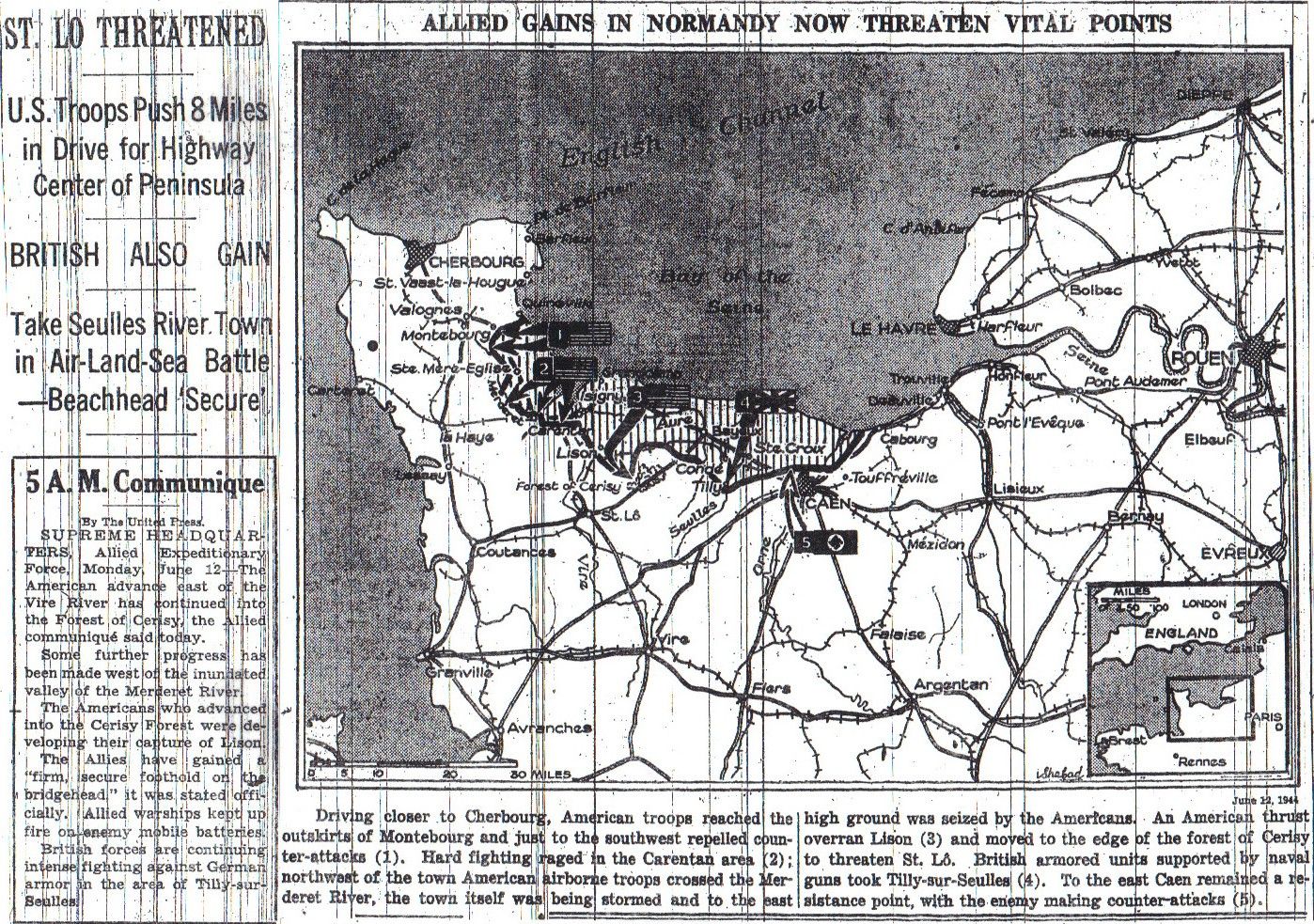
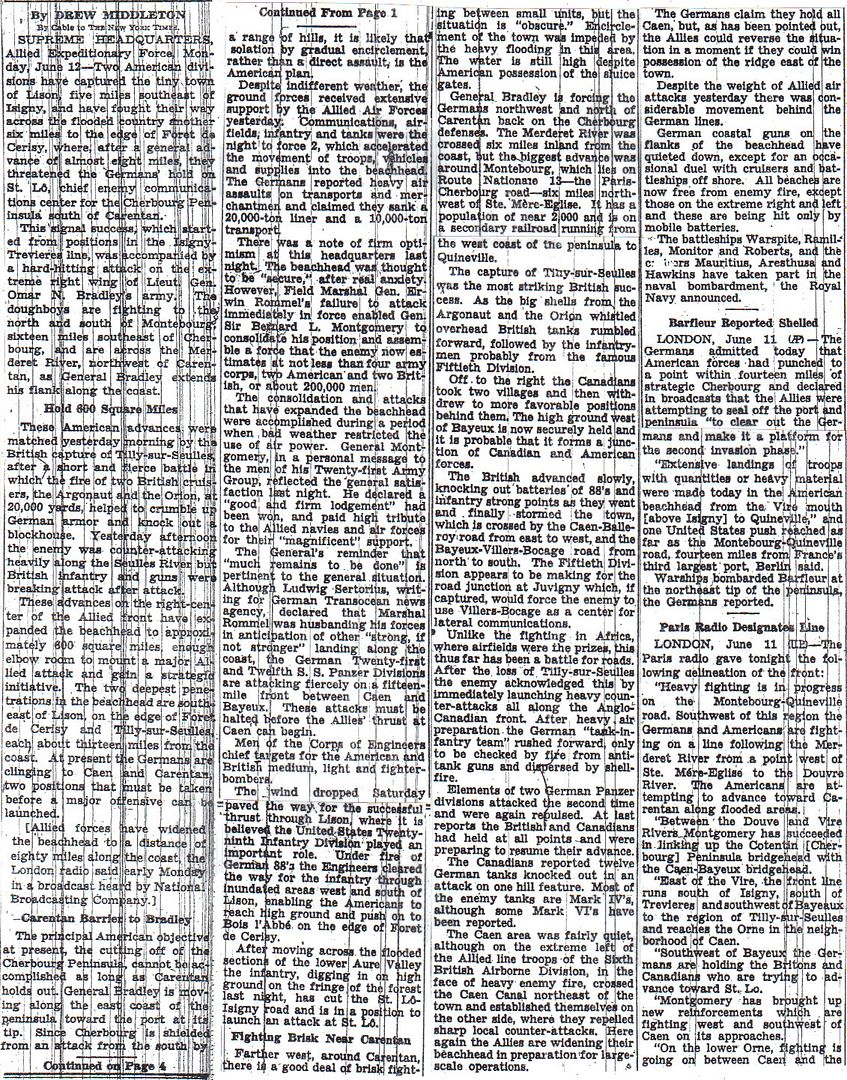
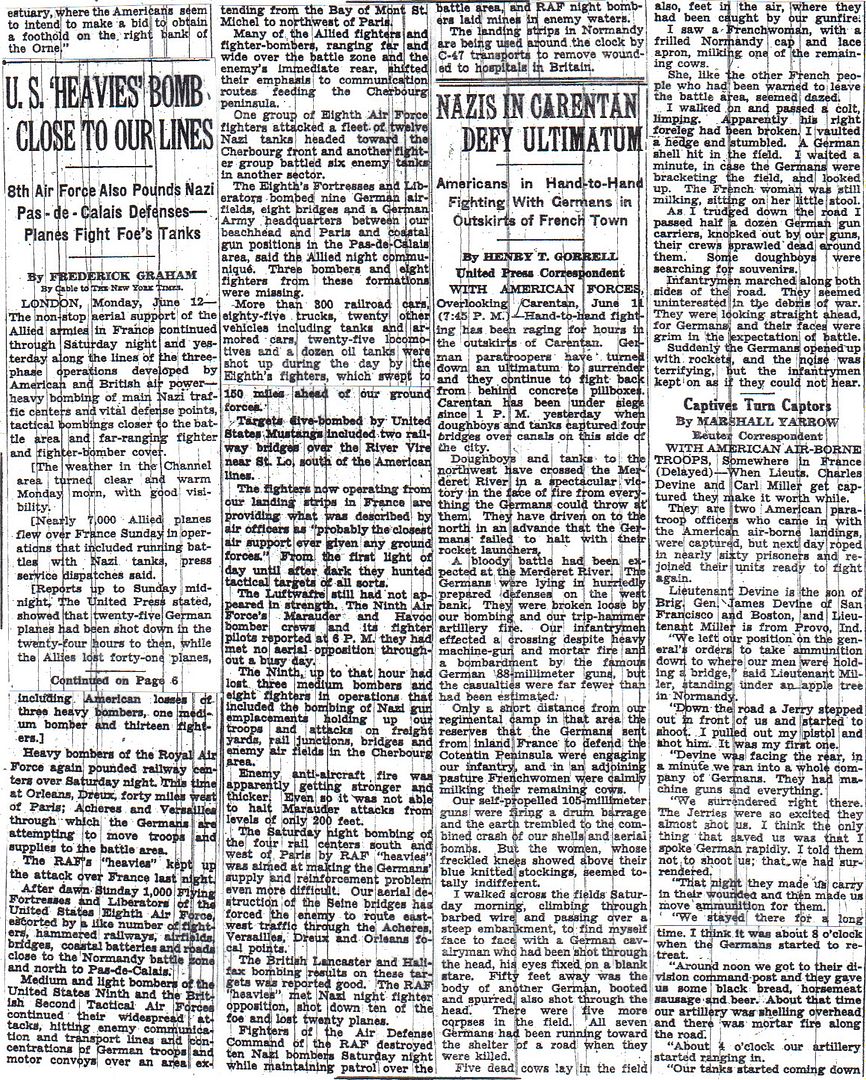
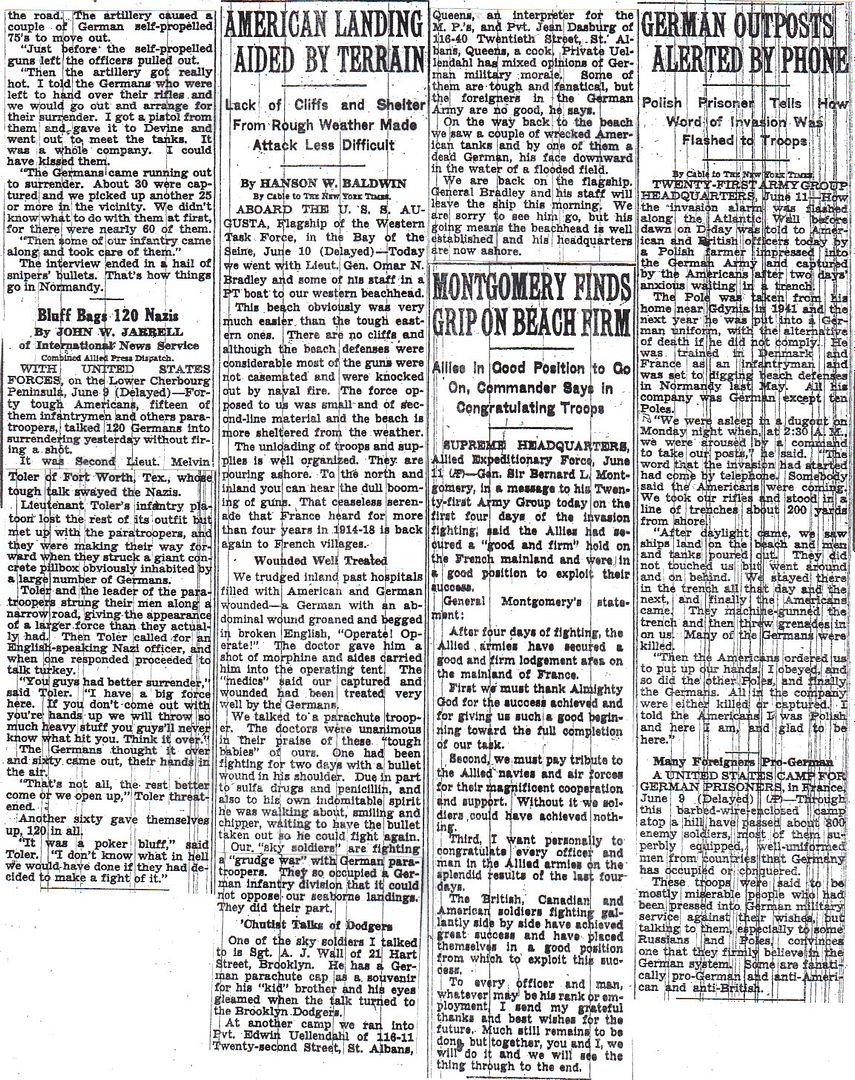
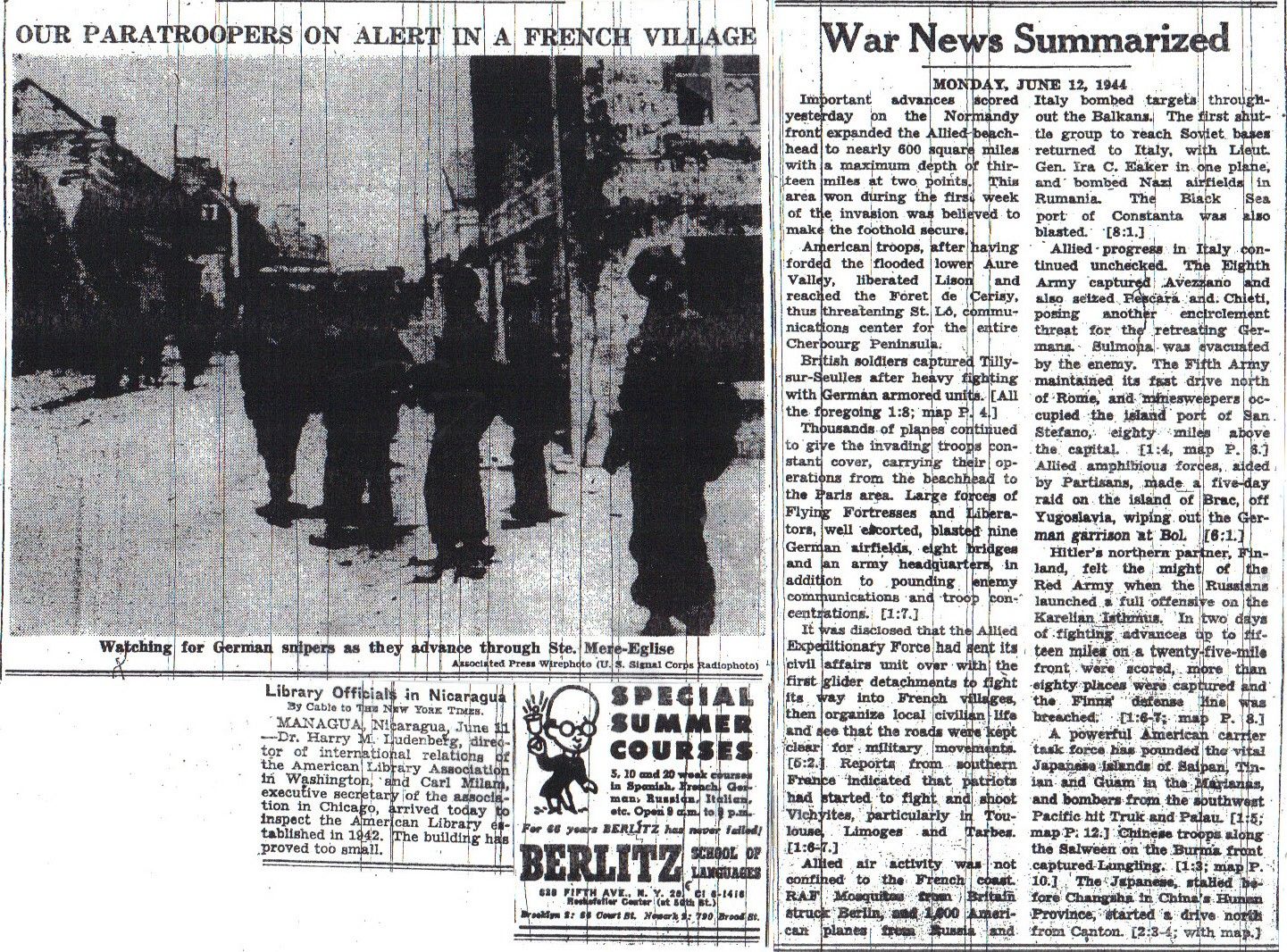
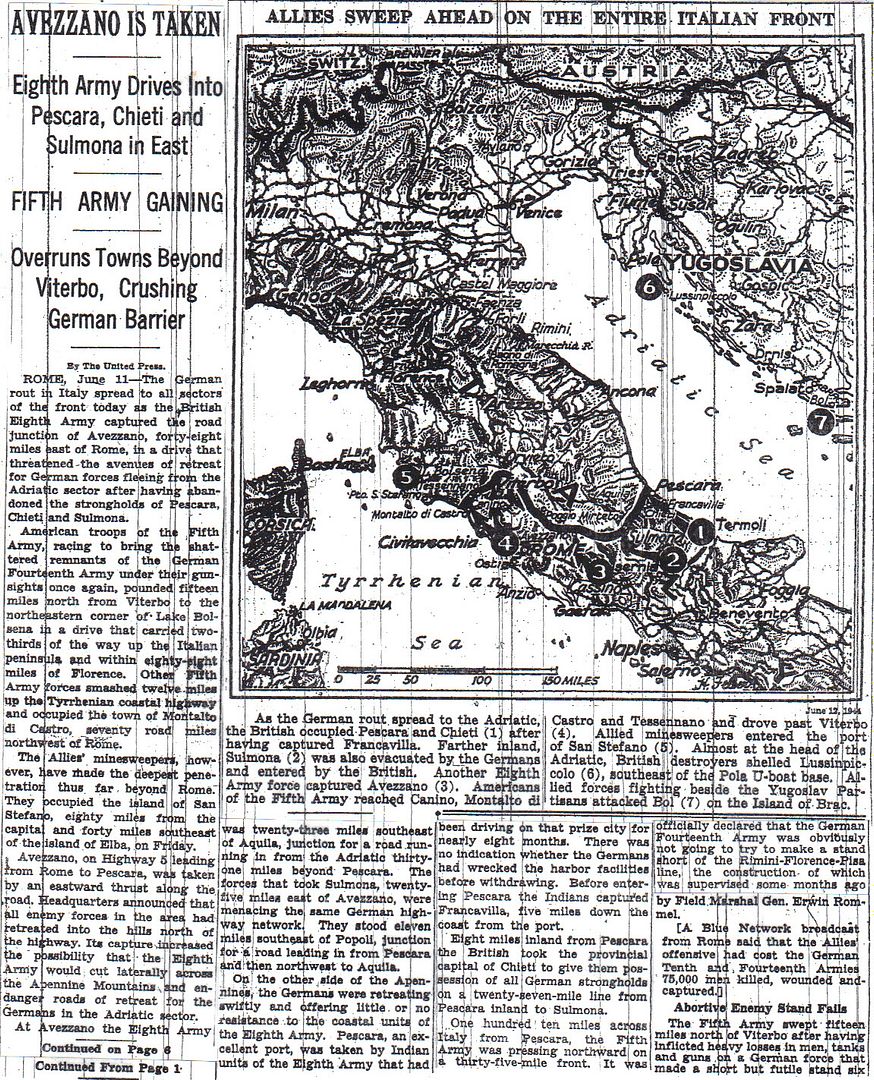
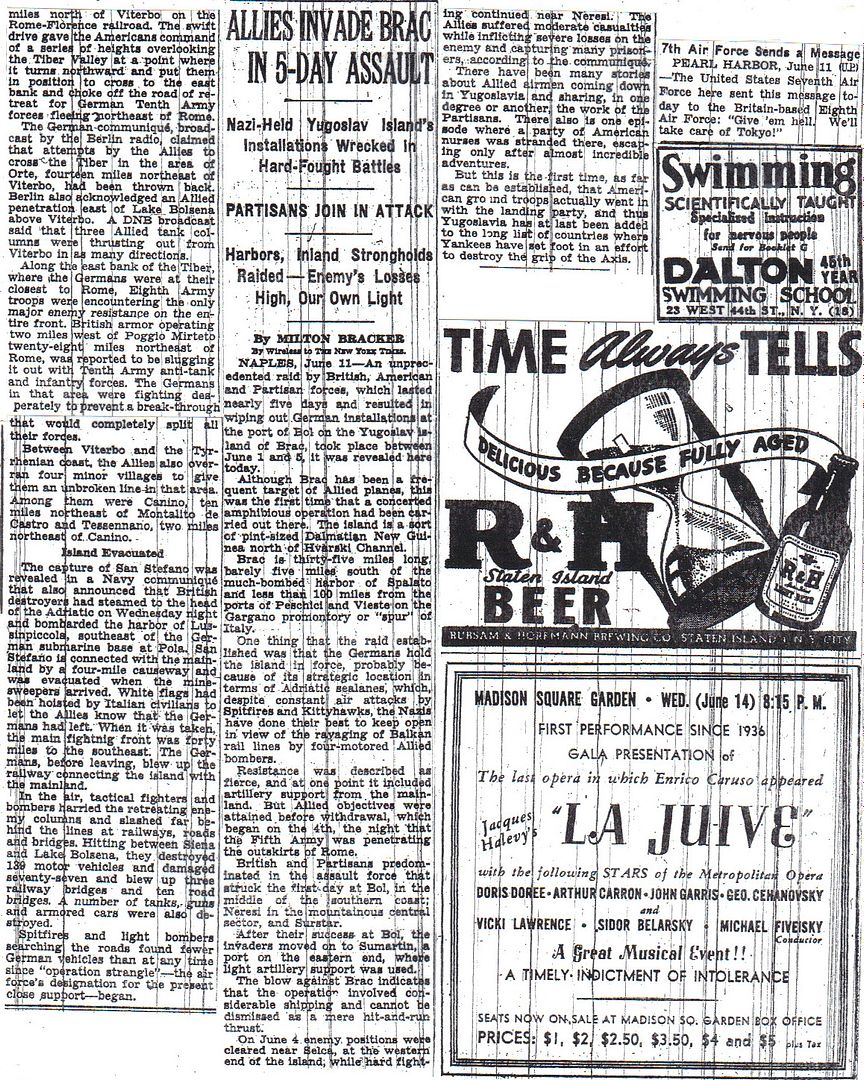
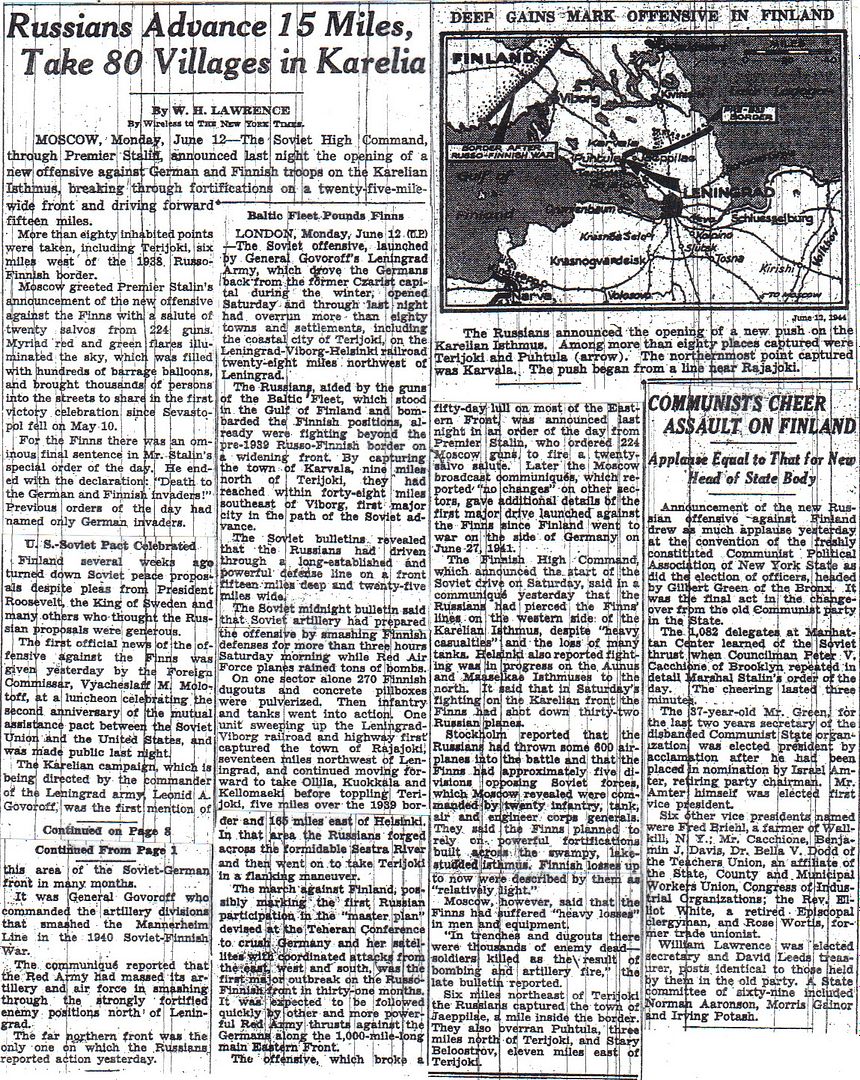
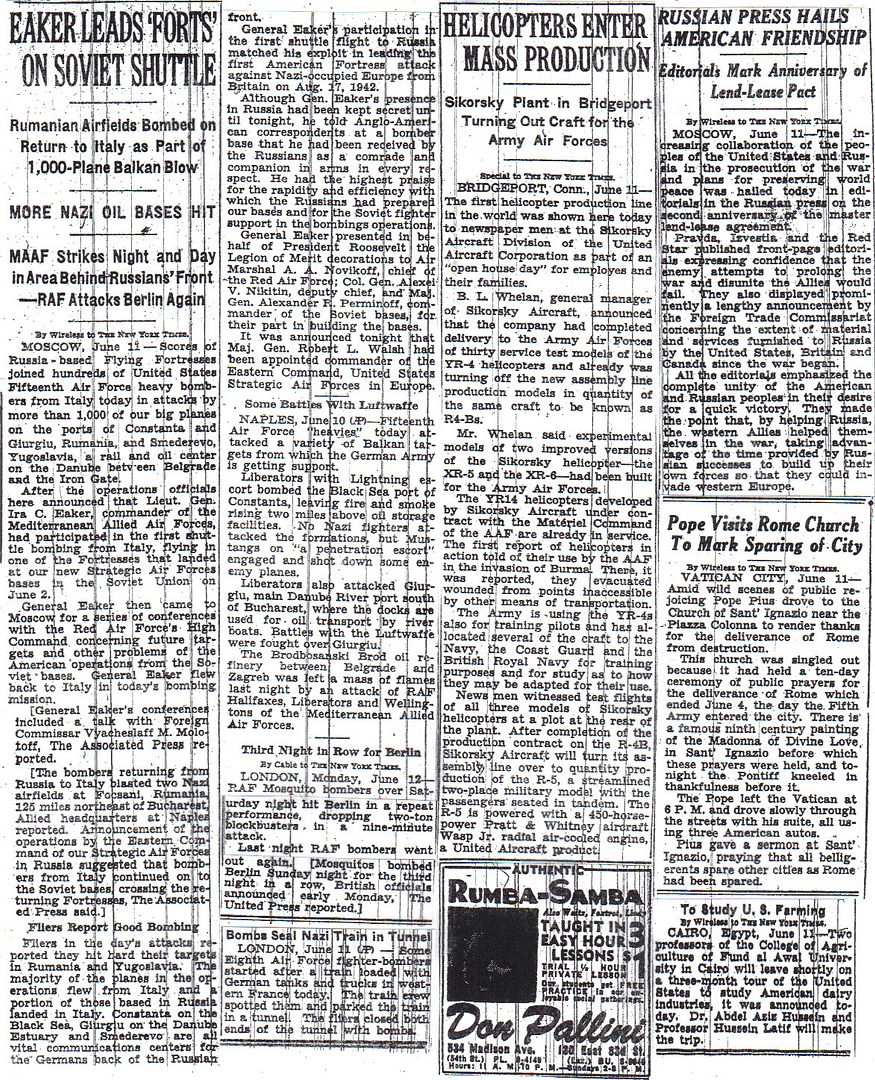
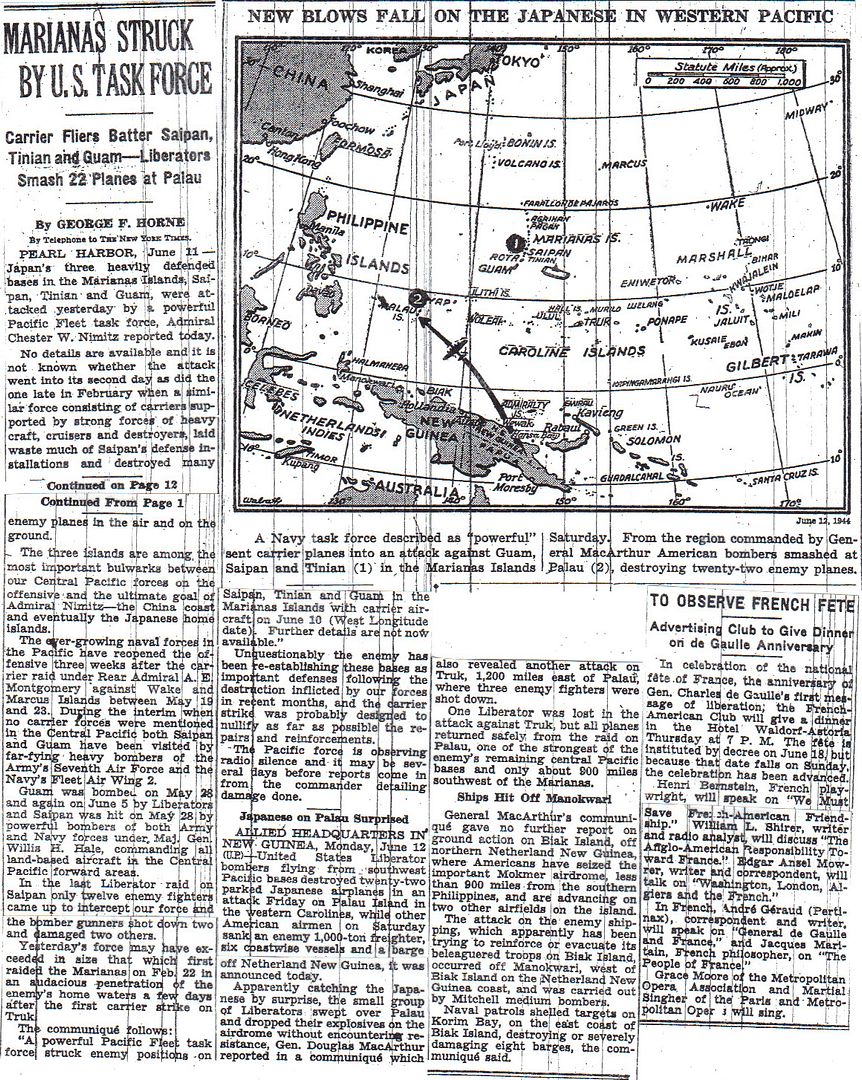
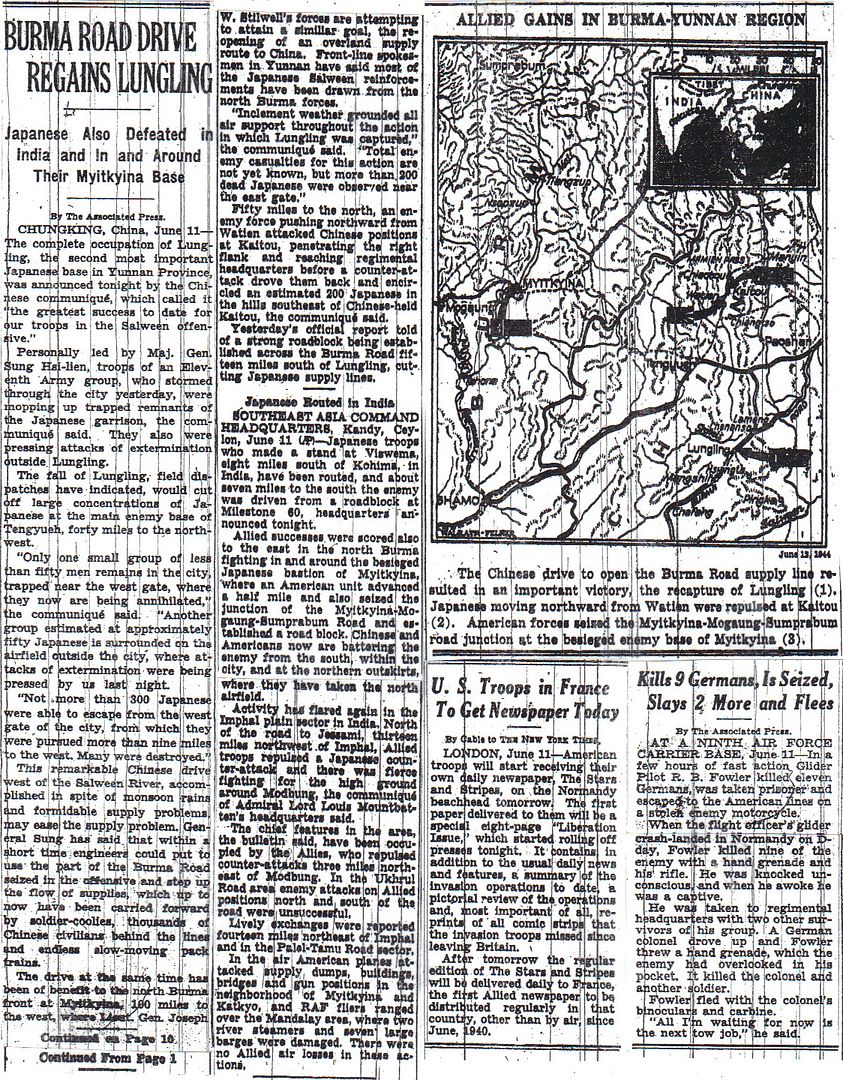
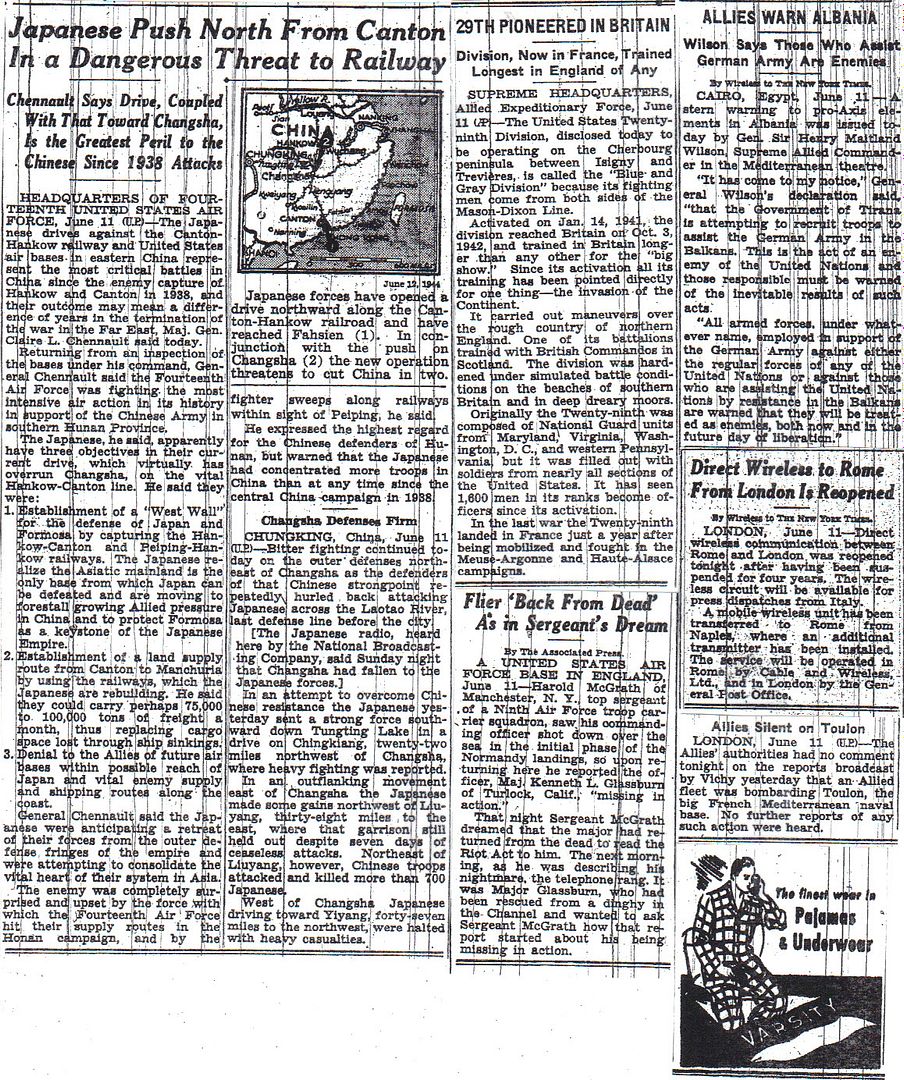
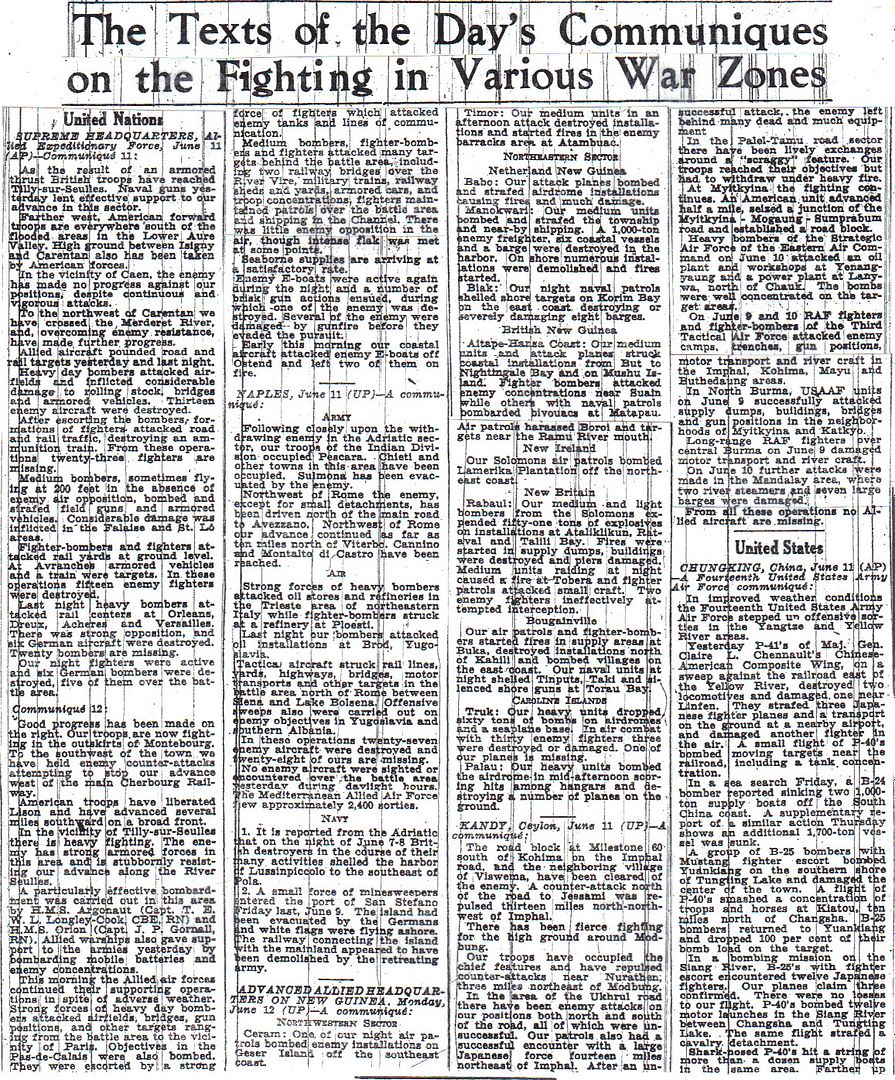
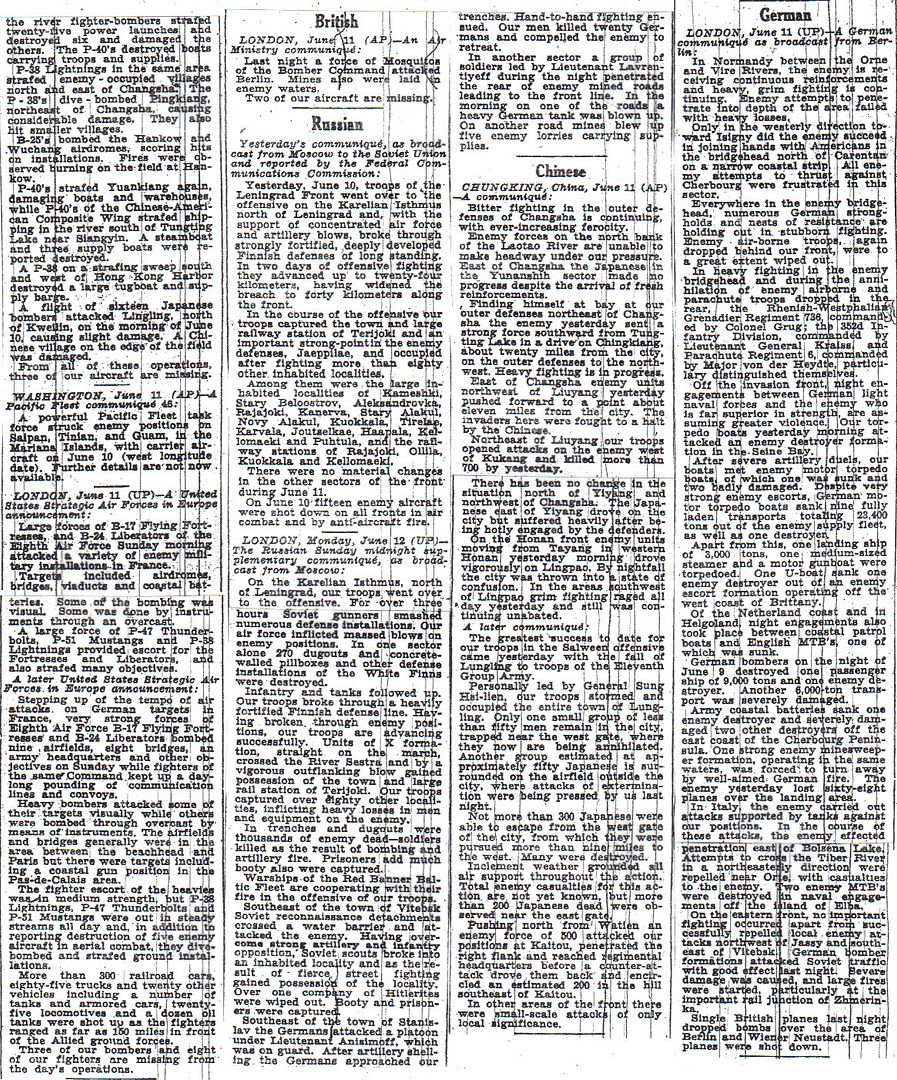

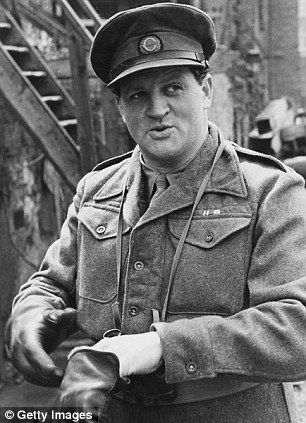
http://www.onwar.com/chrono/1944/jun44/12jun44.htm#
Allied buildup in Normandy continues
Monday, June 12, 1944 www.onwar.com
On the Western Front... A third wave of Allied forces has landed. There are now 326,000 troops, 104,000 tons of supplies and 54,000 vehicles deployed in Normandy, France. Elements of US 7th Corps advance across the Cotentin Peninsula and southwest. Also, the 4th Division is engaged at Montebourg, Crisbecq and near Azeville to the northward drive on Cherbourg. The 5th Corps assists 7th Corps and advances toward St Lo. Caumont is captured and Foret de Cerisy and the Bayeux road are reached.
In Italy... The British 8th Army reaches Popoli along the Adriatic coast.
In the Mariana Islands... US naval forces continue attacks on Japanese positions in the island group. They concentrate on Tinian, Saipan and Guam. The Japanese fleets located at Tawitawi and Batjan set sail to counterattack. Admiral Kurita commands a vanguard force while Admiral Ozawa leads the main force. The main force from Tawitawi is sighted and reported by an American submarine. The Japanese have 5 fleet carriers, 2 light carriers, 2 seaplane carriers, 5 battleships as well as several cruisers and destroyers in support. The commander of the Combined Fleet, Admiral Toyoda, realizes that the American forces are numerically superior but he also expects support from the land-based aircraft on the islands. These air assets, however, are being depleted by American attacks.
http://www.etherit.co.uk/month/thismonth/12.htm
June 12th, 1944 (MONDAY)
UNITED KINGDOM:
The USAAF’s Eighth Air Force in England flies two missions.
Mission 407: With bad weather over top priority targets in Germany, 1,442 bombers are dispatched against airfields and landing grounds in northeastern France and rail and road bridges on the Brest Peninsula; 691 of 769 B-17s and 586 of 673 B-24s hit 16 airfields and six railroad bridges in the Rennes and St Nazaire area; they claim 1-1-0 Luftwaffe aircraft; six B-17s and two B-24s are lost Fighters fly 988 sorties the loss of 16 aircraft:
1. 234 P-38 Lightnings, 80 P-47 Thunderbolts and 201 P-51 Mustangs fly escort, sweeps and patrols over the English Channel and in the Rennes area; they claim 20-0-8 Luftwaffe aircraft in the air and 1-0-0 on the ground; three P-38s, a P-47 and three P-51s are lost.
2. 93 P-38s and 183 P-47s fly fighter-bomber missions against five railroad bridges in the Tours-Paris area; they claim 5-0-2 Luftwaffe aircraft in the air and 1-0-0 on the ground; a P-38 and eight P-47s are lost.
3. 45 P-38s and 152 P-51s fly escort for Ninth Air Force A-20 Havocs and B-26 Marauders.
Mission 408: Seven B-17s drop leaflets on France and Belgium during the night.
Sixteen B-24s fly CARPETBAGGER missions.
The USAAF’s Ninth Air Force in England dispatches 509 B-26s and A-20s to bomb marshalling yards, road and rail junctions, bridges, artillery, town areas, troop concentrations and various targets of opportunity in France; aircraft of 15+ fighter groups fly close and area support for bombers and bomb and strafe rail lines, gun batteries, bridges, fortifications, radar installation, tanks, ammunition dumps, town areas and strongpoints in the battle area.
Submarine HMS Tiptoe commissioned.
ENGLISH CHANNEL: U-1191 reported missing in English Channel. No survivors.
FRANCE: The US 4th Division reaches Montebourg, Crisbecq and Azeville in Normandy. The V Corps reaches Bayeux Road. There are now 326,000 men, 54,000 vehicles and 104,000 tons of supplies landed by the Allies in the beachhead.
German General der Artillerie Erich Marcks LXXXIV AK is killed at St-Lo/Perriers. (138)(Russ Folsom)
Normandy: Montgomery tells reporters “we have won the battle of the beaches”, as Allied forces take Carentan.
Normandy: One of the most remarkable aspects of the whole Overlord operation came into use today off the Normandy coast. This is the “Mulberry” harbour, which is made up of a number of steel structures which are combined to make a floating dock. It will enable supply ships to unload off the landing beaches instead of having to wait until a proper port is in Allied hands.
It was the Dieppe raid of August 1942 which convinced the Allies that to base the Allied invasion of France on the immediate capture of a port was impracticable. Yet, if the armies were to be kept supplied once they were ashore, there had to be facilities available for ships to unload. The British had been thinking about the problem since 1942 and quickly recognized the necessity of taming the often rough Channel seas. Various ideas for doing this were tried, including the use of streams of bubbles to cancel out the waves and vast floats, nicknamed “Lilos”, made of welded rubber with concrete keels.
Eventually it was decided that a rigid breakwater was the best answer. Metal and concrete pontoons known as “Bombardons” were therefore designed and manufactured. After some modification, 15 of these were tested off Weymouth during the spring gales of April this year and passed with flying colours. Because they did not look like anything in particular, they were anchored in south-eastern ports and German air reconnaissance never recognized their significance.
Bombardons enables ships to unload, but the supplies still have to be brought ashore. This is done on “Swiss Roll”, a floating trackway strong enough for heavy lorries. Two Mulberries have been assembled at Arromanches and St. Laurent to support the British and US Armies respectively.
FRANCE: P/O Andrew Charles Mynarski (b.1916), RCAF, was told to leave his blazing Lancaster, but tried to free the rear gunner. He failed and baled out, but died of burns next day. (Victoria Cross)
Frigate HMS Halsted is torpedoed by the units of 9th Schnellboot geschwader in the English Channel at Seine Bay and has her bows blown off, but is able to make port at Portsmouth astern under her own power. She is not repaired. (Alex Gordon)(108)
US Journalist Ernie Pyle arrives in Normandy. His article will be known as a Pure Miracle.
The American and British Chiefs of Staff visit the Normandy beachhead. It is just four years less four days that General Alan Brooke, Chief of the Imperial General Staff, had been driven from France for the second time in two weeks. This return was an emotional experience for him. From his diary entry of 12 June:
“It was a wonderful moment to find myself re-entering France almost exactly 4 years after being thrown out for the second time at St. Nazaire. Floods of memories came back of my last trip of despair, and those long four years of work and anxiety at last crowned by the success of a re-entry into France.”
Brooke then writes of being met on the beach by Monty, motoring to his headquarters, being briefed by him and then having lunch. “. . . my thoughts wandered off to 4 years ago when I was at Le Mans and Laval waiting for Monty and his 3rd Division to join me. [This is of the first time that Brooke was driven from France by the Germans.] I knew then that it would not be long before I was kicked out of France if I was not killed or taken prisoner, but if anybody had told me then that in 4 years time I would return with Winston and Smuts to lunch with Monty commanding a new invasion force I should have found it hard to believe it.”
(William Jay Stone)
The U.S. 501st P.I.R. and the 506th P.I.R., attacked with the mission of establishing defensive positions outside of Carentan. They are stopped by German resistance. Defending are elements of the 17th S.S. Pz. Div., 37th S.S. Pz. Gren. Regt., reinforced by a company of the 17th S.S. Tank Bn., and a platoon of the 17th A.T. Bn.
GERMANY:
U-2330, U-3006 laid down.
U-2321 commissioned.
FINLAND: In Karelian Isthmus, the advancing Soviet units reach VT-line, the second Finnish line of defence. They start immediately probing the defences. The line is held by Gen. Laatikainen’s IV Corps. After Gen. Sihvo’s 10th Division was withdrawn to rear, the line here at the southern part of the front is defended by Gen. Pajari’s 3rd Division and Gen. Melander’s Cavalry Brigade (the Cavalry Brigade fought on foot, its name was an honorary appellation). Together they defend a stretch of line some 40 km (25 miles) wide. Today also Gen. Martola’s 2nd Division reaches the VT-line, after conducting a fighting withdrawal. On the northern part of the Isthmus front Gen. Siilasvuo’s III Corps has so far been left in peace, but it has to transfer troops to defend it’s endangered right flank.
IV Corps’s defences are focused around Kivennapa, where lies the attacker’s shortest way to Viipuri. However, the Leningrad Front commander Gen. Govorov has received permission to act as he sees fit, and he immediately transfers the point of main effort. The attacking Red Army units now concentrate on the very southernmost part of the front, on the coastal road running along the northern shore of the Gulf of Finland, where the Finnish defences are the weakest.
The commander of the Finnish 3rd Brigade (which is on its way to the Karelian Isthmus) Col. Joose Hannula is killed in an aerial attack. He is succeeded by Col. Kai Savonjousi.
However badly things have gone so far for the Finns, there are some signs of hope. Today Hitler rescinds the ban on arms exports he had imposed earlier because of the Finnish peace-feelers. From eastern Karelia, north of Lake Ladoga, the 17th Division (Maj. Gen. Alonzo Sundman) and 20th Brigade (Col. Armas Kemppi) are ordered to transfer to the Isthmus. Finnish AA-defences claim 15 enemy planes shot down.
MEDITERRANEAN SEA: S class submarine HMS Sickle is lost in the Mediterranean / Aegean Sea cause unknown. Last heard of on this date when they reported sighting a convoy in the Steno Channel. Sickle is the last British submarine to be lost in the Mediterranean during WW2. There is one survivor from Sickle: Able Seaman Richard Blake, a member of the submarine’s 3 inch gun crew who was blown over board on 4 June when Sickle had engaged in gunfire with German patrol vessels GA76 and GA91. The submarine had to make an urgent dive to avoid further hits, and Blake was left in the water and picked up by the Germans to become a POW. (Alex Gordon)(108)
CHINA: The Communist leader, Mao Tse-tung, announces that he supports Chiang Kai-shek, the Nationalist leader, in the war against Japan.
MARIANAS ISLANDS: US TF 58 continues to attack Tinian, Siapan and Guam. The Japanese naval forces sail from Tawi Tawi and Batavia, and are sighted. The Japanese intend to fight their “Decisive Battle”. The land element of their plan has been destroyed by the US carrier attacks.
(Jack McKillop adds): Supplementing the above, eight Navy Type 1 Attack Bombers , Allied Code Name “Betty,” based on Truk Island, attack the main body of TF 58 from 0315 to 0415 hours. No damage is done to the US ships and one “Betty” is shot down. Task Group 58.1 consisting of the aircraft carriers USS Bataan, USS Belleau Wood, USS Hornet and USS Yorktown have been detached from the main body of TF 58 to begin air attacks on Guam. The main body of TF 58 attacks Saipan, Tinian, Rota and Pagan Islands in the Mariana Islands. At least ten, and possible fourteen, Japanese ships and numerous fishing vessels have been sunk or damaged near Saipan in two strikes by TG 58.4 (USS Essex, USS Cowpens and USS Langley).
In the first U.S. deployment of a guided missile unit into a combat theater, elements of Special Task Air Group One arrive in the Russell Islands in the South Pacific.
NEW GUINEA: Fierce ground fighting continues on Biak Island while Japanese aircraft attack Allied ground forces and shipping offshore. USAAF Fifth Air Force P-47s shoot down seven IJN Nakajima B5N Navy Type 97 Carrier Attack Bombers, Allied Code Name “Kate,” and an IJA Kawasaki Ki-61 Army Type 3 Fighter Hien, AlliedCode Name “Tony” near Biak between 1030 and 1045 hours.
BURMA: Rfn. Ganju lama (b.1922), 7th Gurkha Rifles, went forward alone under heavy fire and knocked out two Japanese tanks and their crews. (Victoria Cross)
CANADA: Frigate HMCS Cheboque arrived Yarmouth, Nova Scotia.
U.S.A.:
N. D. COMMUNIQUÉ NO. 524, Mediterranean.
1. PC-558 was sunk as a result of enemy action in the Mediterranean on May 9, 1944.
2. The next of kin of casualties have been notified.
N. D. COMMUNIQUÉ NO. 525, Pacific and Far East.
1. U. S. submarines have reported sinking eighteen vessels as a result of operations against the enemy in these waters, as follows:
1 large tanker
1 medium transport
6 medium cargo transports 6 medium cargo vessels
4 small cargo vessels
2. These actions have not been reported in any previous Navy Department communiqué.
CINCPAC PRESS RELEASE NO. 441, Carrier aircraft again struck Guam, Rota, Tinian, and Saipan on- June 11 (West Longitude Date). Truk Atoll was attacked by Liberators of the Seventh Army Air Force at night on June 9 and 10. Airfields at Param, Eten, Dublon and Moen Islands were principal targets. Several fires were started.
Ponape Island was bombed by Seventh Army Air Force Liberators on the night of June 9. Ponape Town and gun positions were hit. Ventura search planes of Fleet Air Wing Two bombed Ocean Island during daylight on June 9, encountering moderate antiaircraft fire.
Two of the planes continued to Nauru Island to strafe small craft there.
On June 10 Mitchells of the Seventh Army Air Force bombed Nauru, and started fires visible twenty miles. Heavy antiaircraft fire downed one Mitchell bomber. A Catalina search plane of Fleet Air Wing Two rescued the crew.
Enemy Positions in the Marshalls were bombed and strafed on June 9, during the night of June 9-10, and on June 10. Corsair fighters and Dauntless dive bombers of the Fourth Marine Aircraft Wing, Catalina search planes of Fleet Air Wing Two and Navy Hellcat fighters participated in these attacks. Coastal defence guns and antiaircraft batteries were hit. (Denis Peck)
Marine Admin Command, V Amphibious Corps becomes Admin Command, Fleet Marine Forces, Pacific. (Gordon Rottman)
Destroyer USS Chevalier laid down.
Light cruiser USS Vicksburg commissioned.
Destroyer escort USS Oswald commissioned.
Submarine USS Bergall commissioned.
ATLANTIC OCEAN: U-490 sunk NW of the Azores in position 42.47N, 40.08W by depth charges from escort carrier USS Croatan, and depth charges from destroyer escorts USS Frost, Huse and Inch.
John F. Kennedy is recognized for his exploit of almost a year ago.
Page 10, upper left headline. Was that your grandfather?
NORMANDY BEACHHEAD, June 12, 1944 – Due to a last-minute alteration in the arrangements, I didn’t arrive on the beachhead until the morning after D-day, after our first wave of assault troops had hit the shore.
By the time we got here the beaches had been taken and the fighting had moved a couple of miles inland. All that remained on the beach was some sniping and artillery fire, and the occasional startling blast of a mine geysering brown sand into the air. That plus a gigantic and pitiful litter of wreckage along miles of shoreline.
Submerged tanks and overturned boats and burned trucks and shell-shattered jeeps and sad little personal belongings were strewn all over these bitter sands. That plus the bodies of soldiers lying in rows covered with blankets, the toes of their shoes sticking up in a line as though on drill. And other bodies, uncollected, still sprawling grotesquely in the sand or half hidden by the high grass beyond the beach.
That plus an intense, grim determination of work-weary men to get this chaotic beach organized and get all the vital supplies and the reinforcements moving more rapidly over it from the stacked-up ships standing in droves out to sea.
*
Now that it is over it seems to me a pure miracle that we ever took the beach at all. For some of our units it was easy, but in this special sector where I am now our troops faced such odds that our getting ashore was like my whipping Joe Louis down to a pulp.
In this column I want to tell you what the opening of the second front in this one sector entailed, so that you can know and appreciate and forever be humbly grateful to those both dead and alive who did it for you.
Ashore, facing us, were more enemy troops than we had in our assault waves. The advantages were all theirs, the disadvantages all ours. The Germans were dug into positions that they had been working on for months, although these were not yet all complete. A one-hundred-foot bluff a couple of hundred yards back from the beach had great concrete gun emplacements built right into the hilltop. These opened to the sides instead of to the front, thus making it very hard for naval fire from the sea to reach them. They could shoot parallel with the beach and cover every foot of it for miles with artillery fire.
Then they had hidden machine-gun nests on the forward slopes, with crossfire taking in every inch of the beach. These nests were connected by networks of trenches, so that the German gunners could move about without exposing themselves.
Throughout the length of the beach, running zigzag a couple of hundred yards back from the shoreline, was an immense V-shaped ditch fifteen feet deep. Nothing could cross it, not even men on foot, until fills had been made. And in other places at the far end of the beach, where the ground is flatter, they had great concrete walls. These were blasted by our naval gunfire or by explosives set by hand after we got ashore.
Our only exits from the beach were several swales or valleys, each about one hundred yards wide. The Germans made the most of these funnel-like traps, sowing them with buried mines. They contained, also, barbed-wire entanglements with mines attached, hidden ditches, and machine guns firing from the slopes.
This is what was on the shore. But our men had to go through a maze nearly as deadly as this before they even got ashore. Underwater obstacles were terrific. The Germans had whole fields of evil devices under the water to catch our boats. Even now, several days after the landing, we have cleared only channels through them and cannot yet approach the whole length of the beach with our ships. Even now some ship or boat hits one of these mines every day and is knocked out of commission.
The Germans had masses of those great six-pronged spiders, made of railroad iron and standing shoulder-high, just beneath the surface of the water for our landing craft to run into. They also had huge logs buried in the sand, pointing upward and outward, their tops just below the water. Attached to these logs were mines.
In addition to these obstacles they had floating mines offshore, land mines buried in the sand of the beach, and more mines in checkerboard rows in the tall grass beyond the sand. And the enemy had four men on shore for every three men we had approaching the shore.
And yet we got on.
*
Beach landings are planned to a schedule that is set far ahead of time. They all have to be timed, in order for everything to mesh and for the following waves of troops to be standing off the beach and ready to land at the right moment.
As the landings are planned, some elements of the assault force are to break through quickly, push on inland, and attack the most obvious enemy strong points. It is usually the plan for units to be inland, attacking gun positions from behind, within a matter of minutes after the first men hit the beach.
I have always been amazed at the speed called for in these plans. You’ll have schedules calling for engineers to land at H-hour plus two minutes, and service troops at H-hour plus thirty minutes, and even for press censors to land at H-hour plus seventy-five minutes. But in the attack on this special portion of the beach where I am – the worst we had, incidentally – the schedule didn’t hold.
Our men simply could not get past the beach. They were pinned down right on the water’s edge by an inhuman wall of fire from the bluff. Our first waves were on that beach for hours, instead of a few minutes, before they could begin working inland.
You can still see the foxholes they dug at the very edge of the water, in the sand and the small, jumbled rocks that form parts of the beach.
Medical corpsmen attended the wounded as best they could. Men were killed as they stepped out of landing craft. An officer whom I knew got a bullet through the head just as the door of his landing craft was let down. Some men were drowned.
The first crack in the beach defenses was finally accomplished by terrific and wonderful naval gunfire, which knocked out the big emplacements. They tell epic stories of destroyers that ran right up into shallow water and had it out point-blank with the big guns in those concrete emplacements ashore.
When the heavy fire stopped, our men were organized by their officers and pushed on inland, circling machine-gun nests and taking them from the rear.
As one officer said, the only way to take a beach is to face it and keep going. It is costly at first, but it’s the only way. If the men are pinned down on the beach, dug in and out of action, they might as well not be there at all. They hold up the waves behind them, and nothing is being gained.
Our men were pinned down for a while, but finally they stood up and went through, and so we took that beach and accomplished our landing. We did it with every advantage on the enemy’s side and every disadvantage on ours. In the light of a couple of days of retrospection, we sit and talk and call it a miracle that our men ever got on at all or were able to stay on.
Before long it will be permitted to name the units that did it. Then you will know to whom this glory should go. They suffered casualties. And yet if you take the entire beachhead assault, including other units that had a much easier time, our total casualties in driving this wedge into the continent of Europe were remarkably low – only a fraction, in fact, of what our commanders had been prepared to accept.
And these units that were so battered and went through such hell are still, right at this moment, pushing on inland without rest, their spirits high, their egotism in victory almost reaching the smart-alecky stage.
Their tails are up. "We’ve done it again," they say. They figure that the rest of the army isn’t needed at all. Which proves that, while their judgment in this regard is bad, they certainly have the spirit that wins battles and eventually wars.
 |
| Ernie Pyle, pictured in Normandy not long after the invasion of Europe. Pyle (left) is shown with Gordon Gammack (center) of the Des Moines Register and Tribune and Don Whitehead of the Associated Press. |
|
|
| IU Archives |
|
 |
A worthy description of what happened on Omaha Beach.
Somehow, he got Hitler to let him do it.
I’m very impressed by Kesselring. I didn’t know anything about him other than his name until I read the Rick Atkinson books.
I believe he said it was, when it came up earlier in the war, and posted a picture of his family at the General’s gravesite.
There were guys Hitler would listen to and guys he wouldn’t. It all depended on whether they had “von” before the last name. He would listen to Model, Kesselring and to some extent, Rommel. He wouldn’t listen to von Rundstedt, von Manstein, and von Kluge.
He really hated the Prussian military caste, and was happy as pie when Judge Freisler strung them up with piano wire.
Interesting!
“John F. Kennedy is recognized for his exploit of almost a year ago.”
My maternal grandfather, who retired a as a LT CMDR, and who was a CO at a naval jungle survival training base at Hilo HI during the war, used to grouse up until he died in 1981 that after all of the amazing personal acts of heroism that were honored during WWII, the guy who lost his ship was the ONLY one who became president!
LOL! It’s an accurate observation. Eisenhower was President, but his heroism was more subtle.
What if Nimitz had political ambitions, though ...
About the same as the driver of a Ferrari being celebrated after being surprised and run over by a steam roller.
Disclaimer: Opinions posted on Free Republic are those of the individual posters and do not necessarily represent the opinion of Free Republic or its management. All materials posted herein are protected by copyright law and the exemption for fair use of copyrighted works.